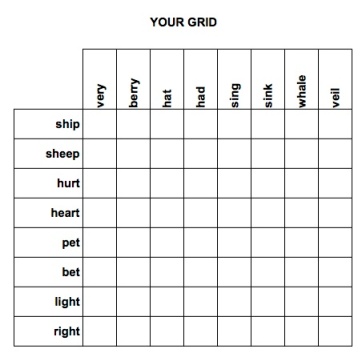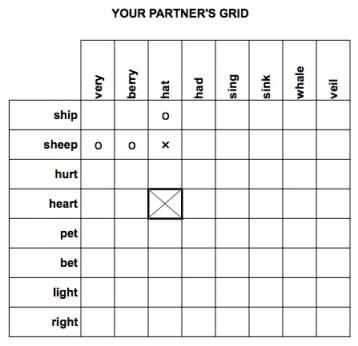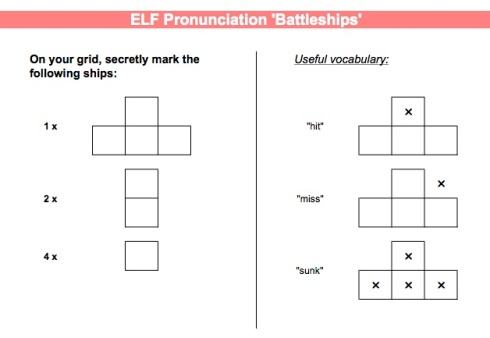This is a variation on the traditional ‘Battleships‘ board game, but designed to practise pronunciation. I’ve used it with my own students many times and they always find it challenging and engaging.
The game involves learners very carefully articulating words in minimal pairs so that their partner can understand precisely which word they’re saying. The idea is to include words in the game which contain sounds that are typically difficult for particular learners of English, depending on their first language background.
Of course, practising minimal pairs over and over and over again has the potential to be mind-numbingly repetitive – but when done in a competitive game format, it’s much more fun!
Printable game boards
You can download ready-to-print PDF game boards tailored for learners from 12 different first languages backgrounds here:
And there are generic boards for the Lingua Franca Core and for one commonly difficult aspect of it here:
To better understand what makes up the ‘Lingua Franca Core’, check out this post. If you want a printable one-page version for your own reference, you can download one here.
Make your own game boards – coming soon!
Of course, if you teach a group of students from various L1 backgrounds, you might like to create your own bespoke game grid that caters for their different L1s, so they can practise understanding and being understood in a true ELF environment.
In this case, we will soon be making available for download the original file used to create the above game boards. It includes lists of appropriate words for 12 different first language backgrounds and a blank game grid so you can make your own bespoke game boards. There are instructions on how to do so in this video.
For your own reference, the file also includes notes on the Lingua Franca core (i.e. the basis of the words selected for inclusion in the game), as well as a bibliography of all the linguistic sources which this data has been based on.
If you aren’t familiar with Battleships and don’t know how to play, read on…
How to play ‘Battleships’
The basics:
- Students work in pairs. In each pair, the students are enemies – not a team!
- The idea is that one student’s grid (marked “YOUR GRID”) represents the ‘sea’, and they must place some ‘ships’ in it to protect from their ‘enemy’ (the other student in the pair).
- They cannot see each other’s ‘seas’ – they must hide their grids from each other.
- They take turns to guess where each other’s ‘ships’ are.
- Whoever ‘sinks’ all of their enemy’s ships first is the winner.
How to set it up:
1. Each student gets a copy of the whole game board (one A4 page).
2. To start with, each student prepares the part marked ‘YOUR GRID’:

3. Individually, they mark 1 big ship, 2 medium-sized ships and 4 little ships on their own game board, by shading in squares. They mustn’t show their partner. When they’re finished, it will look something like this:

Note: they can rotate the ships if they want; and they can put ships close to each other, as long as the ships do NOT touch sides. In other words, this is not allowed:

But this is allowed:

Now they’re ready to play.
How to play:
1. Keeping their grids secret from each other, the students take turns to guess where each other’s ships are.
2. They can only do this by giving coordinates, one square at a time. For example (using the grid above), if I think my partner might have a ship in the third box from the left in the top row, I would say ‘hat, ship’.
3. If my partner has part of a ship in that box, he/she will say ‘hit’. If he/she has an entire ship in that box, he/she will say ‘sunk’. If there is no ship in that box, he/she will say ‘miss’. (This vocabulary is given at the top of the game board:)
4. If I hit something, I mark that square on the grid labelled ‘YOUR PARTNER’S GRID’ with a small ‘x’, then guess again. If I miss, I mark that square with a small ‘o’, so that I remember later in the game that I’ve already tried that square. If I sink a ship, I cross out the whole square with a big ‘X’. As the game goes on, then, the grid labelled ‘YOUR PARTNER’S GRID’ on my sheet of paper will start to look something like this:

As you can see, I have sunk one of his small ships and am in the process of finding another.
AN IMPORTANT NOTE ON CHEATING:
The main points of the game are (1) to practise articulating sounds very clearly so that listeners can differentiate between similar-sounding words, and (2) to practise articulating particularly challenging sounds. So if a student cannot tell what word his/her partner is saying, the partner must clarify by contrasting the two confusing words, and not by defining which word they mean or giving other clues which allow them to avoid the pronunciation challenge!
Example: Student A says hat. Student B isn’t sure if Student A said hat or had. So Student B asks: “Hat or had?” And Student A clarifies, “Not had. Hat.”
5. The game finishes when one student has sunk all of his/her partner’s ships. Then they can look at each other’s grids. By this time, the teacher should have had plenty of opportunity to hear which sounds were causing the most difficulty and might require more work in a future lesson.



great game! i often use the battleship game for learning the phonetic chart from the pronunciation games book by mark hancock; this min pairs version is a very nice complement
ta
mura
Hi Mura, thanks for visiting our new blog. I agree that Battleships is a great classroom game. And I owe a lot to Mark Hancock for years of pronunciation inspiration! 🙂
Agreed great game, and Chinese speaker version, worked well for Lao student I was tutoring.
Thank you soo much.
Edwin
Hi Edwin, thanks so much for taking the time to leave this comment. It’s great to hear when people have used our resources with success!
Pingback: ELF Battleships - printable game boards | Inter...
Pingback: ELF Battleships - printable game boards | Engli...
Reblogged this on mwins435.
Pingback: ELF Battleships - printable game boards | Usefu...
Pingback: Thank you, Harrogate! | ELF Pronunciation
Pingback: ELF Battleships - printable game boards | SECON...
Pingback: Minimal pairs – ‘ELF priorities’ post 1 of 3 | ELF Pronunciation
Hi Laura – this is great; all of my students have enjoyed the battleship activity. Is there anywhere I could download the original file used to create the game boards, so I can adapt them to my students? Thanks, Anna
Hi Anna
Great, glad to hear your students enjoyed the game! We do have plans to make the original file available at some point but so far have encountered some tech issues which I’d like to iron out before sharing. So watch this space!
Best,
Laura
Pingback: Wrap up your lesson! | CreativENGLISHly
Pingback: BELTA webinar: Teaching pronunciation and listening for ELF | ELF Pronunciation
Pingback: Rethinking How We Teach Pronunciation | TESL Ontario Blog